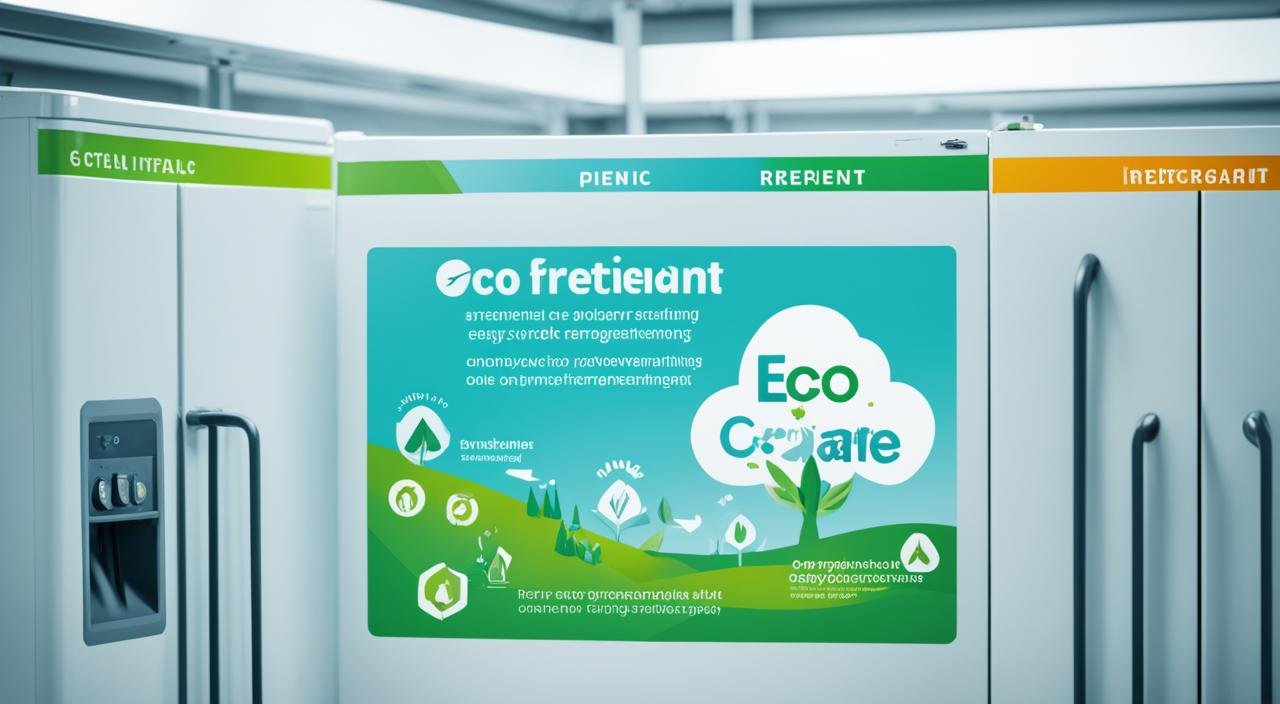Eco-friendly products have a profound impact on the environment and pave the way towards a sustainable future. By embracing eco-friendly choices, individuals can actively contribute to reducing waste and conserving natural resources. This article explores the importance of eco-friendly products, their benefits, and the role they play in mitigating climate change and environmental degradation.
Key Takeaways:
- Eco-friendly products help reduce waste and conserve natural resources.
- Choosing eco-friendly products minimizes negative environmental impact.
- Eco-friendly products reduce pollution and greenhouse gas emissions.
- They promote resource conservation through sustainable materials and practices.
- Technology plays a significant role in promoting sustainable consumption.
Why Choose Eco Friendly Products?
When it comes to protecting our environment and creating a sustainable future, choosing eco-friendly products is a decision that can make a significant impact. Eco-friendly products offer a wide range of benefits that not only benefit the planet but also contribute to our well-being. By understanding the benefits of using eco-friendly products, we can make informed choices that align with our values and make a positive difference.
Reducing Pollution and Greenhouse Gas Emissions
One of the key benefits of eco-friendly products is their contribution to reducing pollution and greenhouse gas emissions. Traditional products often contain harmful chemicals and toxins that pollute the air, water, and soil. In contrast, eco-friendly products are made from natural, non-toxic ingredients that minimize environmental impact. By choosing these products, we can help combat climate change and create a cleaner, healthier environment for ourselves and future generations.
Using Sustainable Materials and Lowering Carbon Footprint
Eco-friendly products are typically made from sustainable materials that are sourced responsibly. These materials include recycled or upcycled materials, organic fibers, and renewable resources. By utilizing these materials, eco-friendly products help conserve natural resources, reduce waste, and minimize the strain on ecosystems. Additionally, eco-friendly products often have a lower carbon footprint due to their sustainable production methods and reduced energy consumption.
Promoting Resource Conservation
Choosing eco-friendly products also promotes resource conservation. These products are designed to be more efficient in their use of water, energy, and natural resources throughout their lifecycle. For example, eco-friendly appliances are built to be energy-efficient, reducing electricity consumption and utility bills. By opting for eco-friendly alternatives, we contribute to the responsible management of resources and support a more sustainable approach to consumption.
In summary, the benefits of using eco-friendly products extend beyond personal convenience and aesthetics. By reducing pollution, utilizing sustainable materials, and promoting resource conservation, these products have a positive impact on the environment. By making eco-friendly choices, we play a part in creating a more sustainable future for ourselves and generations to come.
How Do Eco Friendly Products Reduce Waste?
Eco-friendly products play a crucial role in reducing waste and minimizing the environmental impact. By choosing eco-friendly products, consumers contribute to waste reduction and promote a more sustainable future. These products are designed with the aim of minimizing waste generation and promoting a circular economy.
Eco-friendly products are characterized by their ability to minimize waste through various means:
- Recyclable materials: Many eco-friendly products are made from materials that can be recycled. These materials include paper, glass, metal, and plastic. By using recyclable materials, eco-friendly products reduce the amount of waste that goes to landfills.
- Biodegradable products: Some eco-friendly products are biodegradable, meaning they can break down naturally over time without leaving harmful residues. These products can be composted or degraded through natural processes, reducing the accumulation of waste.
- Use of recycled materials: Eco-friendly products are often made from recycled materials. By utilizing recycled materials, these products reduce the demand for new resources and prevent waste accumulation.
Additionally, eco-friendly products are designed to be more durable and have a longer lifespan compared to conventional alternatives. This reduces the need for frequent replacements, further minimizing waste generation. The use of sustainable materials and production processes also helps in conserving natural resources and reducing the overall environmental impact.
Eco-friendly products promote responsible consumption and production practices, reducing waste generation and minimizing the strain on the environment. By choosing eco-friendly products, individuals can actively contribute to the preservation of our planet.
| Advantages of Eco Friendly Products |
|---|
| Durable and long-lasting |
| Recyclable and biodegradable |
| Reduces waste generation |
| Conserves natural resources |
| Lower carbon footprint |
The Role of Consumer Behavior in Sustainable Consumption
Consumer behavior plays a crucial role in the adoption of eco-friendly products. While many consumers express positive attitudes towards sustainable and eco-friendly products, there is often a gap between intention and action. Understanding consumer behavior can help bridge this gap and encourage sustainable consumption. Factors such as social influence, habit formation, and personal values can influence consumers’ choices and decision-making when it comes to eco-friendly products.
Social influence plays a significant role in shaping consumer behavior towards sustainable consumption. People are influenced by the actions and choices of others, whether it’s their peers, family, or societal norms. When eco-friendly products are perceived as socially desirable and praised, consumers are more likely to adopt them.
“The decisions we make have an impact on the choices of others. By embracing sustainable consumption, we can inspire and motivate those around us to do the same.”
Habit formation is another important aspect of consumer behavior. By repeatedly choosing eco-friendly products, consumers can transform sustainable consumption into a habit. The more ingrained the behavior becomes, the more likely consumers are to continue making eco-friendly choices in the long run.
Personal values also play a significant role in driving sustainable consumption. Consumers who value environmental protection, social responsibility, and a sustainable future are more likely to prioritize eco-friendly products. These personal values serve as a guiding force in shaping consumer behavior and influencing purchasing decisions.
“Our personal values shape our choices. By aligning our values with sustainable consumption, we can create a positive impact on the environment and contribute to a more sustainable future.”
Understanding consumer behavior allows businesses, policymakers, and marketers to develop effective strategies for promoting sustainable consumption. By addressing the factors that influence consumer choices, such as social influence, habit formation, and personal values, stakeholders can create an environment that encourages and supports eco-friendly choices.
Overcoming Barriers to Sustainable Consumption
Several barriers can hinder the adoption of eco-friendly products. These barriers often discourage individuals from making eco-friendly choices, impeding progress towards a more sustainable future. Understanding and addressing these barriers is crucial in promoting and encouraging sustainable consumption.
Higher Price Points
One of the main barriers to sustainable consumption is the perception that eco-friendly products are more expensive than their conventional counterparts. While it is true that some eco-friendly products may come with a higher price tag, it is important to consider the long-term savings and benefits they offer. For example, energy-efficient appliances may have a higher upfront cost, but they can significantly reduce utility bills over time. To encourage eco-friendly choices, businesses can offer pricing incentives such as discounts, promotions, or reward programs to make sustainable products more affordable and accessible.
Limited Availability
Another barrier to sustainable consumption is the limited availability of eco-friendly products. In some regions or communities, it can be challenging to find a wide range of sustainable options. To address this barrier, businesses can focus on expanding their product offerings and distribution channels, ensuring that eco-friendly products are readily available to a larger consumer base. Collaborating with local retailers and suppliers can also help increase the accessibility and availability of eco-friendly options in specific areas.
Lack of Awareness and Information
A lack of awareness and information about eco-friendly products can often prevent consumers from making sustainable choices. Many individuals may not be aware of the environmental benefits or the range of eco-friendly products available on the market. To overcome this barrier, education and awareness campaigns play a vital role. Businesses, organizations, and governments can collaborate to create informative resources, conduct awareness campaigns, and promote sustainable initiatives through various media channels. Providing clear and accessible information about the environmental impact of different products can empower consumers to make informed choices that align with their values.
Perceived Inconvenience
Perceived inconvenience is yet another barrier that can deter individuals from embracing sustainable consumption. Some consumers may find it more convenient to stick with familiar and readily available conventional products rather than making the effort to seek out eco-friendly alternatives. To address this barrier, businesses can focus on improving the convenience and accessibility of eco-friendly options. This can include initiatives such as expanding the availability of eco-friendly products in mainstream retail outlets or offering eco-friendly product subscriptions or delivery services. By making sustainable choices more convenient, businesses can encourage individuals to overcome the perceived inconvenience barrier and embrace eco-friendly alternatives.
By addressing these barriers through pricing incentives, education and awareness campaigns, product availability improvements, and convenience enhancements, consumers can be empowered to make eco-friendly choices. Encouraging sustainable consumption requires a collective effort from businesses, governments, and individuals. By overcoming these barriers, we can work together towards a more sustainable future.
Leveraging Technology for Sustainable Consumption
Technology plays a significant role in promoting sustainable consumption. By harnessing the power of innovation, we can drive eco-friendly practices and create a more sustainable future. Through the development of cutting-edge technologies, businesses and consumers can collaborate to make a positive impact on the environment.
Eco-friendly innovations such as smart appliances, energy-efficient devices, and digital platforms have revolutionized the way we consume and interact with products. These advancements empower consumers to make informed choices by providing them with the necessary information and resources to understand the environmental impact of their decisions.
An excellent example of technology’s role in sustainable consumption is the emergence of smart appliances. These devices are designed to optimize energy usage, adjust settings based on usage patterns, and reduce overall waste. With the ability to monitor energy consumption and make adjustments accordingly, smart appliances enable consumers to minimize their ecological footprint while still enjoying the modern comforts of life.
Additionally, energy-efficient devices have gained immense popularity due to their ability to reduce energy consumption without compromising performance. From energy-efficient light bulbs to eco-friendly electronics, these products play a crucial role in conserving resources and reducing greenhouse gas emissions.
Moreover, digital platforms have transformed the way consumers access and share information about eco-friendly products. With just a few clicks, individuals can explore sustainable alternatives, read user reviews, and compare the environmental impact of various options. These platforms promote transparency in the supply chain, allowing consumers to make informed decisions that align with their values.
Supply Chain Transparency and Traceability
One of the most significant advantages of technology in sustainable consumption is enabling supply chain transparency and traceability. By integrating technology into the manufacturing and distribution processes, businesses can track and monitor the environmental impact of their products from production to disposal.
For instance, blockchain technology has gained attention for its potential in enhancing supply chain transparency. By creating an immutable and decentralized ledger, blockchain enables consumers to trace the origins of a product, ensuring it is produced ethically and sustainably. This level of transparency empowers consumers to support eco-friendly brands and make purchasing decisions aligned with their values.
Additionally, technology enables businesses to implement circular economy strategies, reducing waste generation and promoting resource conservation. Through recycling programs, innovative packaging solutions, and efficient waste management systems, companies can minimize their environmental impact while still meeting consumer demands.
Overall, leveraging technology is essential in driving sustainable consumption. By embracing eco-friendly innovations, businesses and consumers can work hand in hand to protect the planet and create a more sustainable future.
“Technology is not just a tool; it is a catalyst for change. By harnessing its power, we can revolutionize the way we consume and make a positive impact on the environment.” – [Author]
Benefits of Technology in Sustainable Consumption
| Benefits | Explanation |
|---|---|
| Eco-friendly Innovation | Smart appliances, energy-efficient devices, and digital platforms empower consumers to make sustainable choices. |
| Supply Chain Transparency | Technology enables businesses to monitor and trace the environmental impact of products throughout the supply chain. |
| Resource Conservation | Circular economy strategies made possible by technology help reduce waste and promote the efficient use of resources. |
The Global Shift Towards a Green Economy
The global community has recognized the importance of transitioning to a green economy to achieve sustainable development goals. A green economy focuses on resource efficiency, low-carbon practices, and social inclusivity. It promotes sustainable growth and investments in eco-friendly infrastructure, technologies, and practices. Governments, businesses, and individuals all play a role driving this transition towards a greener and more sustainable future.
By embracing a green economy, countries can mitigate the impacts of climate change, reduce environmental degradation, and ensure long-term economic prosperity. Green industries, such as renewable energy, waste management, and sustainable agriculture, provide opportunities for job creation and economic growth while minimizing negative environmental externalities.
The Benefits of a Green Economy
A green economy offers a range of benefits for both society and the environment. Some of the key advantages include:
- Environmental Conservation: A green economy prioritizes the protection and preservation of natural resources, biodiversity, and ecosystems. It promotes sustainable land use, ecosystem restoration, and the use of clean and renewable energy sources.
- Resource Efficiency: By optimizing resource use and reducing waste, a green economy fosters resource efficiency. This includes initiatives such as recycling, circular economy practices, and sustainable production methods.
- Climate Change Mitigation: A green economy focuses on reducing greenhouse gas emissions and addressing climate change. It promotes the use of clean technologies and renewable energy sources to decarbonize various sectors, such as transportation and energy production.
- Social Inclusivity: A green economy aims to ensure equitable access to resources, benefits, and opportunities for all. It emphasizes social justice, poverty eradication, and inclusivity by creating green jobs, providing access to clean water and sanitation, and improving living conditions.
Embracing a green economy requires collaborative efforts between governments, businesses, and individuals. Governments play a crucial role in creating supportive policy frameworks, providing incentives for green investments, and enforcing regulations that promote sustainable practices. Businesses can drive innovation and sustainability by adopting environmentally friendly strategies and technologies, while individuals can contribute through conscious consumption choices and eco-friendly lifestyles.
By transitioning to a green economy, countries can forge a path towards a more sustainable and resilient future for generations to come.
Examples of Green Economy Initiatives
| Industry | Initiative |
|---|---|
| Renewable Energy | Investing in solar, wind, and hydropower projects |
| Sustainable Transportation | Developing electric vehicle infrastructure and promoting public transportation |
| Waste Management | Implementing recycling programs and promoting circular economy practices |
| Sustainable Agriculture | Promoting organic farming, agroforestry, and regenerative practices |
| Green Buildings | Constructing energy-efficient buildings and promoting green building certifications |
The Importance of Environmental Education and Awareness
Environmental education and awareness play a crucial role in promoting sustainable living and encouraging the adoption of eco-friendly products. By educating individuals about the environmental impact of their choices and the benefits of eco-friendly alternatives, we can raise awareness and foster behavior change towards a more sustainable future.
“The only way forward, if we are going to improve the quality of the environment, is to get everybody involved.”
– Richard Rogers
Environmental education can take place in various settings, including schools, communities, and through different media channels, ensuring a wide audience is reached. By providing individuals with knowledge and understanding, we empower them to make informed decisions and take action that contributes to a healthier planet.
The Power of Knowledge
Environmental education equips individuals with the knowledge and tools necessary to make sustainable choices. By understanding the impact of their actions on the environment, individuals are more likely to engage in behaviors that promote sustainable living and support the use of eco-friendly products.
Through environmental education, individuals can learn about concepts such as carbon footprint reduction, waste management, and the importance of conserving natural resources. This knowledge empowers them to make conscious decisions that have a positive impact on the environment.
Increasing Awareness
Raising awareness about the environmental challenges we face is a key step in promoting sustainable living. Environmental education initiatives, awareness campaigns, and media outreach play a vital role in disseminating information and engaging the public.
These efforts not only inform individuals about the problems we face, but also highlight the potential solutions and the positive impact of eco-friendly products. By raising awareness, we can inspire individuals to take action and make sustainable choices in their daily lives.
Inspiring Positive Action
Environmental education aims to inspire positive action and behavior change. By providing individuals with the knowledge and understanding of environmental issues, they are empowered to make choices that support sustainable living.
Whether it’s reducing single-use plastic, conserving energy, or supporting brands that prioritize sustainability, every small action contributes to a collective effort towards a more sustainable future. It’s through education and awareness that individuals are motivated to make these changes and become champions for the environment.
Image:
| Benefits of Environmental Education and Awareness | Examples of Environmental Education Initiatives |
|---|---|
| Increased knowledge about environmental issues Promotion of sustainable living practices Encouragement of eco-friendly product adoption Reduction of environmental impact Creation of a more sustainable future | Environmental education programs in schools Community awareness campaigns Documentaries and media coverage Online resources and platforms Corporate sustainability initiatives |
Sustainable Consumption in Developing Countries
Sustainable consumption is not limited to developed countries; it is equally important in developing countries. In these regions, the adoption of eco-friendly products can contribute to environmental conservation, economic growth, and social well-being. However, unique challenges such as affordability, limited access, and cultural factors need to be considered. Efforts should be made to promote sustainable consumption in developing countries through education, policy support, and collaboration with local communities.
In developing countries, the adoption of sustainable consumption practices is crucial for achieving long-term environmental sustainability. By prioritizing eco-friendly products and practices, these countries can mitigate the negative impacts of industrialization and urbanization on the environment.
“The well-being of developing countries is closely linked to sustainable consumption. By adopting eco-friendly products, these countries can achieve a balance between economic growth and environmental preservation,” explains Dr. Catherine Blake, an environmental sustainability expert.
“Promoting sustainable consumption in developing countries requires a comprehensive approach that addresses the unique challenges they face. It involves creating awareness, enabling affordability, and ensuring accessibility to eco-friendly products and services,” emphasizes Dr. Blake.
Education plays a vital role in driving sustainable consumption practices in developing countries. By raising awareness about the environmental impact of consumption choices, individuals can make informed decisions and contribute to a greener future. Schools, community organizations, and government initiatives can collaborate to incorporate environmental education into curricula and outreach programs.
Policy support is another critical aspect of promoting sustainable consumption in developing countries. Governments can implement regulations and incentives that encourage the production and adoption of eco-friendly products. These policies can include tax breaks for sustainable businesses, subsidies for eco-friendly technologies, and sustainable procurement practices.
The Role of Collaboration
Collaboration between different stakeholders is essential for driving sustainable consumption in developing countries. Governments, businesses, non-profit organizations, and local communities need to work together to create a supportive ecosystem that fosters the adoption of eco-friendly products.
“We need to bring everyone to the table, from policymakers to manufacturers and consumers, to address the challenges and find innovative solutions that promote sustainable consumption,” says Dr. Maria Santos, a sustainability advocate.
Collaboration can take various forms, including public-private partnerships, knowledge sharing between organizations, and community engagement. By working together, these stakeholders can leverage their strengths and resources to overcome barriers and accelerate the adoption of eco-friendly products and practices.
| Challenges | Solutions |
|---|---|
| Affordability | – Providing subsidies or financial incentives for eco-friendly products – Promoting local production of eco-friendly alternatives to reduce costs |
| Limited Access | – Improving distribution networks and infrastructure – Establishing community-led initiatives to make eco-friendly products more accessible |
| Cultural Factors | – Highlighting the cultural and social benefits of sustainable consumption – Partnering with local influencers and community leaders to promote eco-friendly practices |
Efforts to promote sustainable consumption in developing countries have the potential to create a positive ripple effect. By embracing eco-friendly products and practices, these countries can not only protect their natural resources but also create new economic opportunities and improve the overall well-being of their communities.
Strategies for Promoting Sustainable Consumption
Promoting sustainable consumption is essential for creating a greener future and reducing our environmental footprint. It requires a comprehensive approach that involves individuals, organizations, and governments coming together to drive positive change. By adopting the following strategies, we can encourage behavior change and support sustainability initiatives:
Raising Awareness through Campaigns
Effective awareness campaigns play a crucial role in promoting sustainable consumption. By highlighting the benefits of eco-friendly products and showcasing the environmental impact of our choices, we can educate and inspire individuals to make more conscientious decisions. These campaigns can be conducted through various channels, including social media, television, and community events.
Incentives and Rewards for Eco-Friendly Choices
Providing incentives and rewards serves as a powerful motivator for consumers to choose eco-friendly options. Businesses can offer discounts, loyalty programs, or other rewards to encourage sustainable behavior. Governments can also implement policies that promote sustainable consumption by providing tax incentives, subsidies, or grants for sustainable products and practices.
Policies and Regulations Supporting Sustainability
Implementing robust policies and regulations is crucial for creating an enabling environment for sustainable consumption. Governments can set environmental standards, enforce eco-labeling requirements, and impose penalties on unsustainable practices. By creating a level playing field and holding businesses accountable, these policies drive the adoption of eco-friendly products and services.
Fostering Collaboration and Partnerships
Collaboration between businesses, governments, and consumers is key to driving sustainable consumption. By working together, we can leverage collective resources and knowledge to develop innovative solutions, share best practices, and support sustainability initiatives. These partnerships can foster a culture of sustainability and accelerate the transition to a more environmentally conscious society.
Table: Examples of Sustainable Consumption Strategies
| Strategy | Description |
|---|---|
| Incentives and Rewards | Offering discounts, loyalty programs, and rewards for choosing eco-friendly options |
| Education and Outreach | Conducting awareness campaigns to educate individuals about the benefits of sustainable consumption |
| Policies and Regulations | Implementing policies and regulations that support sustainable practices and discourage harmful ones |
| Collaboration and Partnerships | Fostering collaboration between businesses, governments, and consumers to drive sustainable consumption |
By combining these strategies at individual, organizational, and societal levels, we can promote sustainable consumption and pave the way for a more sustainable future. Together, let’s embrace eco-friendly choices and support sustainability initiatives for the benefit of our planet and future generations.
Conclusion
Eco-friendly products are essential for reducing the environmental impact and building a sustainable future. By choosing eco-friendly products, individuals can actively contribute to waste reduction, resource conservation, and the reduction of greenhouse gas emissions. However, achieving sustainable consumption requires a collective effort involving consumers, businesses, and governments.
By embracing eco-friendly practices and supporting sustainable initiatives, we can create a more environmentally conscious society and make a positive impact on the planet for future generations. It is crucial for consumers to actively choose eco-friendly products that have a lower environmental footprint. This includes products made from recycled materials, biodegradable options, and those designed to be recyclable or reusable.
Businesses also play a vital role in promoting sustainable consumption by offering eco-friendly alternatives and adopting sustainable practices throughout the supply chain. Governments can support this transition by implementing policies and regulations that incentivize and encourage sustainable production and consumption.
In conclusion, by making conscious choices and prioritizing eco-friendly products, we can collectively contribute to a greener and more sustainable future. Together, we can ensure a healthier planet for ourselves and generations to come.
FAQ
How do eco-friendly products help the environment?
Eco-friendly products help the environment by reducing pollution and greenhouse gas emissions, conserving natural resources, and promoting resource conservation.
What are the benefits of using eco-friendly products?
Using eco-friendly products reduces the negative impact on the environment, promotes waste reduction, and contributes to a more sustainable future.
How do eco-friendly products reduce waste?
Eco-friendly products are designed to be recyclable, biodegradable, or made from recycled materials, minimizing waste going to landfills and promoting a circular economy.
What role does consumer behavior play in sustainable consumption?
Consumer behavior influences the adoption of eco-friendly products; understanding factors such as social influence, personal values, and habit formation can encourage sustainable choices.
What barriers hinder the adoption of eco-friendly products?
Barriers to eco-friendly product adoption include higher price points, limited availability, lack of awareness and information, and perceived inconvenience.
How can technology contribute to sustainable consumption?
Technology enables consumers to make eco-friendly choices through innovations like energy-efficient devices and digital platforms that provide information on the environmental impact of products.
What is a green economy and its importance?
A green economy focuses on resource efficiency, low-carbon practices, and social inclusivity, promoting sustainable growth and investment in eco-friendly infrastructure and practices.
How does environmental education and awareness promote sustainable living?
Environmental education and awareness raise individuals’ understanding of the environmental impact of their choices and promote behavior change towards adopting eco-friendly alternatives.
Is sustainable consumption important in developing countries?
Yes, sustainable consumption in developing countries contributes to environmental conservation, economic growth, and social well-being, despite unique challenges like affordability and limited access.
What strategies can be used to promote sustainable consumption?
Strategies for promoting sustainable consumption include awareness campaigns, incentives for eco-friendly choices, policy support, and collaboration between businesses, governments, and consumers.





